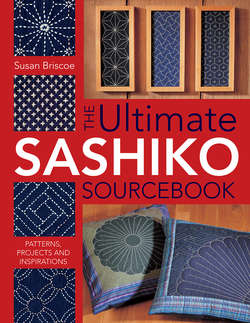Читать книгу The Ultimate Sashiko Sourcebook - Susan Briscoe - Страница 8
На сайте Литреса книга снята с продажи.
The sashiko stitch
ОглавлениеOld sashiko combines fabric in two or three layers, with the best cloth on the top, and even the most complicated patterns are made with simple running stitch. Today, it may have only one layer or include polyester or cotton quilt wadding (batting). Layers of old, worn fabric were formerly used instead of wadding, so vintage sashiko is much flatter than traditional Western quilts. The stitches themselves create the textured pattern, sitting on the fabric surface. The patterns in this book fall into two main groups – moyōzashi (pattern sashiko) and hitomezashi (one stitch sashiko) – and can be used together on the same project to great effect. Many hitomezashi patterns have horizontal or vertical stitches only, which looks like pattern darning, although modern hitomezashi is not worked as a counted thread technique. Kogin and Nanbu hishizashi (top of page 13) are thought to have evolved from this kind of sashiko.
Late 19th century fishermen wearing donza (long work coats) heavily sashiko stitched for warmth and wear.
FROM WONDERS OF JAPAN, 1904
Moyōzashi (pattern sashiko) has curved or straight lines of running stitch which change direction to make larger patterns but the stitches do not cross. The threads are not counted, although the stitches may be. Continuous lines and doubled thread give sashiko strength and warmth.
Hitomezashi (one stitch sashiko)
This is typical of Shōnai in Yamagata Prefecture and is worked as a grid of straight lines, where stitches meet or cross to make the design. Some of the patterns resemble blackwork embroidery or Indian kantha quilting. Very dense hitomezashi patterns may use only one thread.
